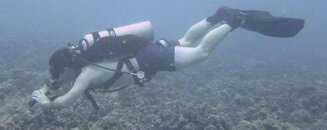Hi Kenny,
Congratulations on ordering your Infinity system! We know you will love it!
Part of what Dr. Lecter is describing is due to the fact that that the Halcyon corrugated hose is generally shorter than those you see on other buoyancy compensators and wings, so the 'standard' length inflator hoses will kind of bow and stick out funny or be too short for a combined alternate air source. The infinity will be shipped with the proper length inflator hose. The shorter corrugated hose places the inflator in the ideal position to be captured by the large rubber o-ring (or in some cases shock cable) that should come installed in combination with the left shoulder d-ring.
Halcyon dive gear is designed so that you can swim "in trim" (flat body with knees bent a bit like dr. lecters picture as opposed to vertical) and be able to dump air from the wing with the butt dump with little or no effort (you pull the little string towards the surface, not 'down - aka towards the bottom, which is what most people try to do when just getting started).
So in this case you can keep the corrugated tube (or i've seen some folks just capture the inflator hose before hooking it to the inflator) under the o-ring/shock cord, which keeps the inflator from dangling down and being a hazard for both entanglement or reef damage. You reach your hand up to your left chest d-ring and voila! the inflator will always be exactly RIGHT there, and you never have that stress'd moment searching around for it.
When its time to dump gas of course you can bend the corrugated tube a bit a bit ind kind of a J shape (to put it slightly higher in the water colum), go slightly head up and roll a little so the gas in the wing migrates to the 'highest point" and press the deflate button (you don't have to have it loose to dump is what i'm trying to describe) or what is more quickly and commonly done is just reach back with your left hand and sweep back (feeling the bottom of your tank) and find the little string and butt dump which means you don't have to change your attitude in the water at all. (if butt dumping feels like you are not dumping any gas you may need to work on getting in better trim or go slightly head down, but more commonly its a matter of pulling the string towards the surface).
If you have not used a back plate and wing system before or have a mentor or instructor to help you set it up, please take the time to find someone or watch some of the user videos. The system is designed to be used with the crotch strap, this will keep everything stable and secure on your back. Feel free to PM me with questions.
With regards to the long hose system for your regulator that Dr. Lecter touched on, that is an excellent way to make sure you know that your buddy's backup (the regulator on the long hose that is in your mouth) is working, and the backup is on a necklace around your neck so you can quickly and easily put it in your mouth, again, just like with the inflator, without having to search for it. Once everyone has gas, you finish deploying the long hose and it allows both divers to make a controlled comfortable ascent without being jammed together which makes an already stressful situation even more complex. When diving the hoses are routed in a manner that will keep them streamlined and in close to the body which again will minimize potential entanglement or environmental damage.
It is a holistic system designed for the most efficiency and comfort in the water, whilst putting you in an orientation that will limit potential impact on the environment by keeping your fins up off the bottom coral or substrate, and gear configuration that is streamlined and tidy, without things hanging in a manner that they might damage coral or other delicate environments.
Happy Diving!
-Laura
[video=youtube_share;pBhm-_zjDwQ]http://youtu.be/pBhm-_zjDwQ[/video]

 out of the way. Having an octoinflator on the end of a long corrugated hose would detract from the primary point of a BP&W rig: streamlined simplicity.
out of the way. Having an octoinflator on the end of a long corrugated hose would detract from the primary point of a BP&W rig: streamlined simplicity.
